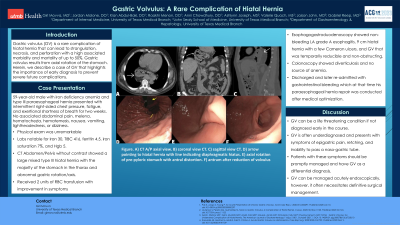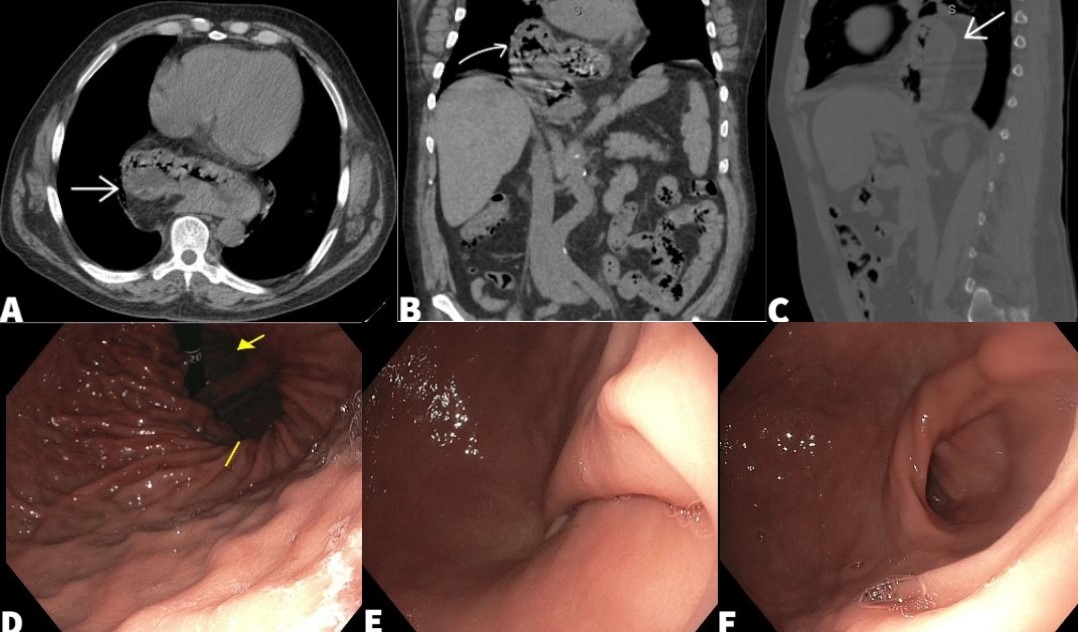Monday Poster Session
Category: Stomach
P2828 - Gastric Volvulus: A Rare Complication of Para-Esophageal Hernia
Monday, October 23, 2023
10:30 AM - 4:15 PM PT
Location: Exhibit Hall

Has Audio
- GM
Giri Movva, MD
University of Texas Medical Branch
Galveston, TX
Presenting Author(s)
Giri Movva, MD1, Jordan Malone, DO1, Kian Abdul-Baki, DO1, Raakhi Menon, DO1, Anni Chowdhury, DO1, Ashlynn Joseph, BSc2, Valerie Quach, BSc2, Jaison S. John, MD1, Gabriel Reep, MD1
1University of Texas Medical Branch, Galveston, TX; 2John Sealy School of Medicine, University of Texas Medical Branch, Galveston, TX
Introduction: Gastric volvulus (GV) is a rare complication of hiatal hernia that can lead to strangulation, necrosis, and perforation with a high associated morbidity and mortality of up to 50%. Gastric volvulus results from axial rotation of the stomach. Herein, we describe a case of GV that highlights the importance of early diagnosis to prevent severe future complications.
Case Description/Methods: 59-year-old male with a past medical history of iron deficiency anemia and type III paraesophageal hernia presented with intermittent right-sided chest pressure, fatigue, and exertional shortness of breath for two weeks. He had no associated abdominal pain, melena, hematochezia, hematemesis, nausea, vomiting, lightheadedness, or dizziness. The physical exam was unremarkable. Labs were significant for Iron 30, TIBC 416, ferritin 4.5, iron saturation 7%, and Hgb 5. Computed Tomography (CT) Abdomen and Pelvis without contrast showed a large mixed type III hiatal hernia with the majority of the stomach in the thorax and abnormal gastric rotation/axis. The patient received two units of packed RBC transfusion and iron infusion with improvement in symptoms. Esophagogastroduodenoscopy (EGD) showed non-bleeding LA Grade A esophagitis, a 9 cm hiatal hernia with a few Cameron ulcers, and GV that was temporarily reducible and non-obstructing. Colonoscopy showed diverticulosis and no source of anemia. The patient was discharged and later re-admitted with gastrointestinal bleeding at which time his paraesophageal hernia repair was conducted after medical optimization.
Discussion: GV can be a life-threatening condition if not diagnosed early in the course. GV is often underdiagnosed and presents with symptoms of vomiting, epigastric pain, retching, and inability to pass a nasogastric tube. Any patient with these symptoms should be promptly managed and have GV as a differential diagnosis. GV can be acutely managed endoscopically; however, it often necessitates definitive surgical management.

Disclosures:
Giri Movva, MD1, Jordan Malone, DO1, Kian Abdul-Baki, DO1, Raakhi Menon, DO1, Anni Chowdhury, DO1, Ashlynn Joseph, BSc2, Valerie Quach, BSc2, Jaison S. John, MD1, Gabriel Reep, MD1. P2828 - Gastric Volvulus: A Rare Complication of Para-Esophageal Hernia, ACG 2023 Annual Scientific Meeting Abstracts. Vancouver, BC, Canada: American College of Gastroenterology.
1University of Texas Medical Branch, Galveston, TX; 2John Sealy School of Medicine, University of Texas Medical Branch, Galveston, TX
Introduction: Gastric volvulus (GV) is a rare complication of hiatal hernia that can lead to strangulation, necrosis, and perforation with a high associated morbidity and mortality of up to 50%. Gastric volvulus results from axial rotation of the stomach. Herein, we describe a case of GV that highlights the importance of early diagnosis to prevent severe future complications.
Case Description/Methods: 59-year-old male with a past medical history of iron deficiency anemia and type III paraesophageal hernia presented with intermittent right-sided chest pressure, fatigue, and exertional shortness of breath for two weeks. He had no associated abdominal pain, melena, hematochezia, hematemesis, nausea, vomiting, lightheadedness, or dizziness. The physical exam was unremarkable. Labs were significant for Iron 30, TIBC 416, ferritin 4.5, iron saturation 7%, and Hgb 5. Computed Tomography (CT) Abdomen and Pelvis without contrast showed a large mixed type III hiatal hernia with the majority of the stomach in the thorax and abnormal gastric rotation/axis. The patient received two units of packed RBC transfusion and iron infusion with improvement in symptoms. Esophagogastroduodenoscopy (EGD) showed non-bleeding LA Grade A esophagitis, a 9 cm hiatal hernia with a few Cameron ulcers, and GV that was temporarily reducible and non-obstructing. Colonoscopy showed diverticulosis and no source of anemia. The patient was discharged and later re-admitted with gastrointestinal bleeding at which time his paraesophageal hernia repair was conducted after medical optimization.
Discussion: GV can be a life-threatening condition if not diagnosed early in the course. GV is often underdiagnosed and presents with symptoms of vomiting, epigastric pain, retching, and inability to pass a nasogastric tube. Any patient with these symptoms should be promptly managed and have GV as a differential diagnosis. GV can be acutely managed endoscopically; however, it often necessitates definitive surgical management.

Figure: Figure 1. A) CT A/P axial view. B) coronal view CT. C) sagittal view CT. D) arrow pointing to hiatal hernia with a line indicating diaphragmatic hiatus. E) axial rotation of pre-pyloric stomach with antral distortion. F) antrum after reduction of volvulus
Disclosures:
Giri Movva indicated no relevant financial relationships.
Jordan Malone indicated no relevant financial relationships.
Kian Abdul-Baki indicated no relevant financial relationships.
Raakhi Menon indicated no relevant financial relationships.
Anni Chowdhury indicated no relevant financial relationships.
Ashlynn Joseph indicated no relevant financial relationships.
Valerie Quach indicated no relevant financial relationships.
Jaison John indicated no relevant financial relationships.
Gabriel Reep indicated no relevant financial relationships.
Giri Movva, MD1, Jordan Malone, DO1, Kian Abdul-Baki, DO1, Raakhi Menon, DO1, Anni Chowdhury, DO1, Ashlynn Joseph, BSc2, Valerie Quach, BSc2, Jaison S. John, MD1, Gabriel Reep, MD1. P2828 - Gastric Volvulus: A Rare Complication of Para-Esophageal Hernia, ACG 2023 Annual Scientific Meeting Abstracts. Vancouver, BC, Canada: American College of Gastroenterology.
